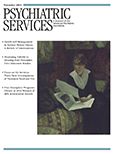Using Claims Data to Generate Clinical Flags Predicting Short-Term Risk of Continued Psychiatric Hospitalizations
Abstract
Objective:
As health information technology advances, efforts to use administrative data to inform real-time treatment planning for individuals are increasing, despite few empirical studies demonstrating that such administrative data predict subsequent clinical events. Medicaid claims for individuals with frequent psychiatric hospitalizations were examined to test how well patterns of service use predict subsequent high short-term risk of continued psychiatric hospitalizations.
Methods:
Medicaid claims files from New York and Pennsylvania were used to identify Medicaid recipients ages 18–64 with two or more inpatient psychiatric admissions during a target year ending March 31, 2009. Definitions from a quality-improvement initiative were used to identify patterns of inpatient and outpatient service use and prescription fills suggestive of clinical concerns. Generalized estimating equations and Markov models were applied to examine claims through March 2011, to see what patterns of service use were sufficiently predictive of additional hospitalizations to be clinically useful.
Results:
A total of 11,801 individuals in New York and 1,859 in Pennsylvania identified met the cohort definition. In both Pennsylvania and New York, multiple recent hospitalizations, but not failure to use outpatient services or failure to fill medication prescriptions, were significant predictors of high risk of continued frequent hospitalizations, with odds ratios greater than 4.0.
Conclusions:
Administrative data can be used to identify individuals at high risk of continued frequent hospitalizations. Payers and system administrators could use such information to authorize special services (such as mobile outreach) for such individuals to promote service engagement and prevent rapid rehospitalizations.



